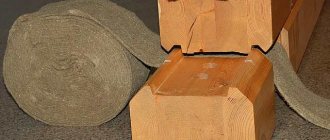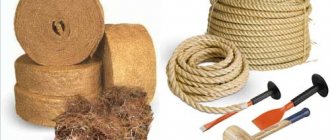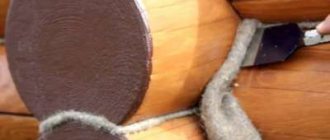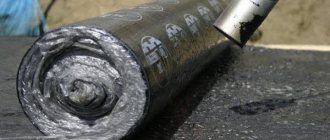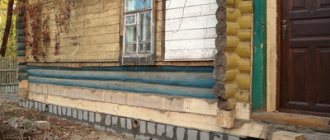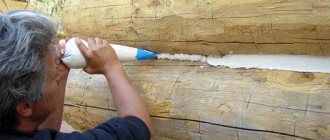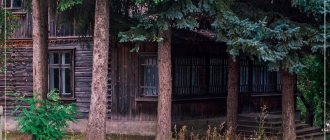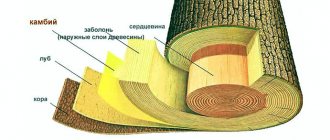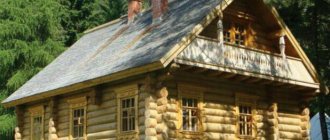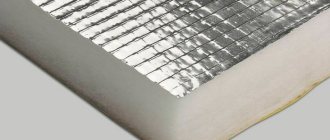Purpose of interventional insulation
Inter-crown insulation is a special type of heat-insulating materials that are laid between the crowns of a wooden building (house, bathhouse, utility room) to eliminate gaps. They can be loose (tow, moss) or in the form of ribbons (felt, batting).
The main task of such insulation is to create comfortable living conditions inside the house. Interventional insulation creates a favorable microclimate only if it can:
- keep the house warm in winter and prevent it from overheating in summer;
- avoid drafts;
Insulation of a log house with moss.
- compensate for changes in the linear dimensions of wood that appear during drying or swelling during changes in environmental humidity (so that cracks do not appear);
- protect owners from unnecessary noise;
- prevent insects from appearing in the house;
The main functions of interventional insulation.
- prevent the colonization of inter-crown space by microorganisms.
In order to perform its assigned functions, inter-crown insulation for timber (logs) must have a certain set of quality characteristics.
What is the best gasket for logs in a log house? Expert opinion
A variety of building materials are used to build houses, bricks, concrete panels, cinder blocks, but the highest quality and most durable material is wood. Houses built from wood are warm, durable and very beautiful. Such houses can be built from either timber or logs, but it is the second version of the material that is being used more and more often, due to its most optimal cost and at the same time its excellent characteristics. In the construction of a log house, the main thing is its insulation and the correct choice of insulation material, of which there are many.
Operational Requirements
High-quality insulation for the crowns of a wooden house must have:
- low level of thermal conductivity to ensure minimal heat loss - the best performance for natural materials;
- high vapor permeability - the walls must breathe, ensuring natural air exchange between the street and the room;
- the ability to absorb moisture well and quickly release it (dry), which allows you to maintain the same moisture content of the timber or log around the entire circumference (the processes of the occurrence of multidirectional stresses inside the timber, leading to its cracking, and the appearance of mold (rot) between the crowns are eliminated). The best in this indicator are flax and jute, but synthetic heat insulators do not absorb liquid - it remains on the fibers. Therefore, artificial insulation materials are not used in bathhouses - the walls will begin to rot;
- uniform density - there will be no cold bridges;
- high elasticity, which allows you to tightly close the gap between the crowns when the house shrinks and the walls swell or dry out;
- resistance to fungus and mold;
- resistance to ultraviolet radiation (sun) and the vagaries of nature (rain, snow, heat, frost);
- long service life comparable to the durability of a house;
- optimal ratio between thickness and density (indicators are given in Table 1);
Table 1. Optimal ratio of thickness and density.
| Thickness, mm | Density, g/m2 |
| 5 | 400 |
| 6-7 | 600 |
| 8-10 | 600-700 |
| 10-15 | 800 |
- environmentally friendly - does not contain components harmful to health;
- sufficient tape width. There are 2 rules here.
- At frost temperatures of -20oC, the width of the thermal insulator should be at least 10 cm, -30oC - 12 cm or more, -40-50oC - 14-18 cm.
- Insulation that is 5 mm smaller in width than the groove will help you get a beautifully designed inter-crown space. If further insulation of the gap is planned with the same material (caulking), the tape should be 10-15 cm larger than the contact area of the crowns.
Synthetic insulation
Synthetic thermal insulation for the gaps between the crowns of the wall is represented by polyester fibers. The general advantages of this type of insulation include:
- durability - manufacturers talk about a service life of 100 years;
- low thermal conductivity coefficient;
- vapor permeability;
- elasticity (volume is restored by 90% after prolonged compression);
- frost resistance.
There are two disadvantages:
- high cost of 1 linear meter;
- do not absorb water, as a result of which a greenhouse effect occurs indoors, and the wood becomes moldy. Therefore, good ventilation of the house and careful wood processing are needed.
The result of using low-quality synthetic inter-crown insulation is fungus at the joints of the crowns.
The best representatives in the segment of synthetic insulation are “Holofiber” and “PoliTerm”.
"Holofiber"
Inter-crown insulation “Holofiber” (translated as “hollow thread”) is one of the varieties of padding polyester known to everyone. It is a springy polyester fiber molded into a tape that perfectly adapts to changes in the linear dimensions of wood during deformation due to shrinkage or changes in humidity. This property is especially valuable for a log house made of sawn timber without grooves. The insulation perfectly holds the volume, ensuring complete tightness, so that re-caulking is not done.
Holofiber insulation.
It goes on sale in rolls and sheets of different densities and elasticity, which allows you to make a choice based on the characteristics of the wood.
Among the advantages :
- excellent elasticity;
- good noise and thermal insulation properties;
- long service life;
- simple installation;
- no need for re-caulking;
- environmental cleanliness;
- resistance against negative biological factors (birds do not carry, insects do not appear).
Negative include :
- “biting” price;
- artificial origin;
- there is a risk of mold or a special type of rot, about which people say: “the tree is rotting.”
"PolyTerm"
Insulation of gaps between the crowns of a wooden house "PoliTerm" is the result of the work of Finnish technologists. Let us immediately note two features:
- when developing the heat insulator, “Holofiber” was taken as a basis, as a result, the result was a type of padding polyester insulation;
- short production period (appeared on the market about 10 years ago), and therefore we cannot give an objective assessment of the advantages and disadvantages of the material (manufacturers can say whatever they want).
What is beyond doubt is:
- convenient release form - in the form of an adhesive tape;
- resistance to any vagaries of nature;
- high price (10-12 times more expensive than jute tape);
- lack of vapor permeability.
Insulation "PolyTerm".
Sold in the form of tapes with a width of 30 to 250 mm and a thickness of 80-200 mm.
Brick baths
Brick is an environmentally friendly material, but only in addition to being decorative, because various additives are used in its manufacture. Of all the existing bricks, choose lightweight varieties with existing voids inside; baths made of such material will last a long time. The main advantage of brick buildings is their fire resistance and resistance to biological damage. You can build a brick bathhouse on several floors; it will be stable and can be erected easily and quickly.
The disadvantages include the high cost of a brick; building a bathhouse from it can cost several times more than a wooden one. In addition, it is necessary to carry out interior finishing; it is advisable to cover it with clapboard or linden boards. The structure of a brick bathhouse is heavy, so you need to build a powerful, strong strip foundation, which requires significant financial costs. Brick also has good thermal conductivity, so all walls must be carefully insulated.
Popular manufacturers and prices
On sale inter-crown insulation made from natural plant fibers are represented by the following brands: “Thermo-Hanf”, “Val-Flax”, “ThermoLen” (“ThermoJUT”), “Flaxan”, “Ekoteplin”, “Ecoterm”, “Ekolen”, etc. ., both Russian-made and European manufacturers. More detailed information about them is given in the work: “Review of flax insulation.”
Let us separately note the prices. So, for 1 linear m with a thickness of 5 mm, a width of 15 cm and a density of 450 g/m2 must be laid out for products from:
- flax - 11 rubles;
- jute - 13 rubles;
- jute mixed with flax - 12 rubles.
With changes in thickness and width, as well as density, prices also change.
Synthetic insulation is produced by:
- "Holofiber" - enterprise "Thermopol" (Moscow);
- "Polytherm" is a center for inter-crown insulation (Moscow).
For comparison, we present the price per 1 linear meter. the same parameters as natural fibers - 32.7-43.6 rubles.
Which insulation and in what case to choose
Inter-crown insulation is selected for the type of building and type of log (beam), since the requirements for heat insulation, for example, in a bathhouse and a residential building, are different.
House
For log houses made of pine (the logs are not the same size along the entire length), it is recommended to use any type of insulation. If it is linen or jute inter-crown insulation (felt or batting), the tape should be 15-18 mm thick, with a density of about 800 g/m2, or two layers of flax (jute felt) should be laid, each 8-10 mm thick, with a density of 600 g/m2. For poorly dried wood, you need 3-4 layers of tape insulation with a thickness of 8-10 mm and a density of 500-600 g/m2.
You can use tow or moss. In this case, the thickness of the insulating layer should be around 15 mm. Now let’s clarify which inter-crown insulation for timber to choose:
- glued - any type of insulator with a thickness of 4-6 mm and a density of 300-400 g/m2 is used;
- profiled: thickness - 2-3 mm, density - 250-350 g/m2;
- simply sawn: thickness - 8-10 mm, density - 400-500 g/m2.
For rounded logs, you need a tape 10-12 mm thick and a density of 500-600 g/m2 or tapes 5-6 mm thick and a density of 400 g/m2, which are laid in 2 layers.
Bath
The bathhouse requires inter-crown insulation made from natural fibers (moss, jute, linen) - it does not accumulate moisture (there will be no rot), provides natural air exchange, is resistant to microorganisms, and does not collapse under conditions of elevated temperature and humidity.
As in a residential building, each type of wall requires its own type of insulation. But there is a nuance here: due to the lower static load on the insulation (the bathhouse is smaller in size), heat insulators with other parameters are required, the values of which are given in the table. 2.
Table 2. Basic parameters of insulation for a bath.
| Wall type | Thickness, mm | Density, g/m2 |
| Hand-cut pine log house | 15 | 400-500 |
| Rounded log for a bathhouse | 5-10 | 450-550 |
| Round log for steam room | 5 | 600 |
| Sawn timber | 4 | Z50-450 |
| Profiled timber | 4 | 250-350 |
Baths made of timber
A bathhouse built from timber is also environmentally friendly, but only in addition to laminated timber. Walls made of profiled and laminated timber do not require additional processing. And internal and external finishing should be done for baths from edged and unplaned timber. The foundation for the construction of a timber bathhouse can be built lightweight, because the material itself and the structure made from it are light in weight. You can assemble a bathhouse from timber in a short time. Caulking and insulation work must be carried out for the walls of the bathhouse made of edged timber. But planed, edged and profiled structures do not need additional insulation. It is better not to use laminated veneer lumber for the construction of a bathhouse, because... it may not withstand high temperatures or temperature changes and may crack.
It is advisable to build baths from wooden materials, not brick. After all, wood breathes, thereby constantly circulating air and regulating the microclimate in the room. They mainly use coniferous trees, and when heated, they release substances into the air that are beneficial for the respiratory system and the entire body as a whole. Of all the materials, the most profitable construction of a bathhouse is carried out using rounded logs and profiled timber.
A real Russian bathhouse is a home “center” where you can improve your health. However, everyone knows that a sauna requires high temperatures, to achieve which a lot of fuel is spent, and, therefore, your money. Therefore, even at the time of construction, the issue of insulating a wooden structure should be carefully considered.
As for the process of insulating a bathhouse, its beginning must necessarily be based on the choice of inter-crown insulation , the best options for which are moss and jute tow. Actually, we will talk about which of the listed materials is better for us to choose in this article.
Materials and tools
To insulate the gaps between the crowns you will need:
- interventional insulation;
- hook for removing old caulk;
- Lebeza (flat spatula) for caulking - needed for sealing cracks;
- flat chisel - seals seams in corners;
- lebeza (narrow thin wedge) to expand the grooves;
- triangular caulk with a groove - it is used to form rollers;
- disk for caulking thin grooves;
Caulking tools. a - hook for removing old caulk; b - swan for caulking; c - winch for expanding the grooves; g - disk for caulking thin grooves.
- wooden mallet - helps to hammer the insulation into the cracks;
- construction stapler.
Log baths
Log baths were built by our grandfathers back in the last century. Now they are no less popular. A sauna built from logs is environmentally friendly. External and internal decoration of the walls can be done at will, although they already look good. It is advisable to build a columnar or strip foundation for a log bathhouse, you need to look at its dimensions and the weight of the wooden material.
The disadvantages of building a bathhouse from logs include the fact that it will be necessary to insulate the walls and caulk. And also the fact that it will be impossible to cope with heavy logs alone; you will need to use special equipment. And cutting out corner joints is not easy.
But still, a log bathhouse is a good, one might say the best, option in terms of ecology.
Technology for insulating inter-crown gaps
Carefully following the instructions for insulating the gaps between the crowns will not help achieve the expected effect if some rules are not followed:
- insulation should be carried out in warm weather;
- the surface of the wood must be dried and cleaned of debris;
- the material is laid in the same layer throughout the entire frame. In this case, you need to look for the “golden mean”, because if the tape is too thick, there will be no normal shrinkage (it will affect it over time), and if it is thin, drafts will appear (you can see the relationship between thickness and density above);
- work is carried out from the bottom up and immediately along the perimeter of the crown. It is forbidden to insulate several cracks between beams on one wall at once, ignoring other walls (there is a risk of distortion during shrinkage);
- the material laid on the log is grabbed in several places with a stapler;
- no rolling of insulating tape into bundles;
- The edges of the tape should not hang from the wall.
The rules are simple. Their implementation is not difficult. Installation of interventional insulation is carried out in several stages.
Stage I. The wood is dried and treated with antiseptics and fire retardants. Materials and tools are being prepared.
Stage II. Thermal insulation is laid between the crowns.
Stage III. The walls are caulked - the gaps between the crowns are tightly filled. It is carried out twice: immediately after insulation and 1-1.5 years after the house shrinks.
conclusions
As you can see, these insulation options have quite a lot of advantages. However, the question of which one to choose has still not been resolved. Basically, it's up to you to decide. But, as a little advice, we want to draw your attention to moss, since its use can protect your structure from significant problems. Unfortunately, this cannot be said about jute tow (despite all its positive qualities), which means that this type of inter-crown insulation should be used if you do not want to assemble the frame of your bathhouse with moss. But this is our conclusion and many believe that inter-crown jute can be confidently placed in 1st place when choosing a gasket for the grooves of a log or cobblestone bathhouse. We will not argue with this, since we consider inter-crown jute, along with moss, to be a very good choice as a natural insulation between the crowns of saunas and baths.
Methods for insulating gaps
Regardless of the chosen insulation material, the tape is laid using several methods:
- without fold;
- with one-sided fold;
- with double-sided bend (see picture).
Scheme of laying tape insulation.
No bend. This method is only suitable for laminated timber, when when laying the crowns small technological gaps are obtained. The tape is rolled out along the top of the beam (log) on all walls and secured with a construction stapler. After this, the next crown is laid.
With one-sided bend. The method is used for timber with minor deviations in linear dimensions. To do this, take a strip of insulation that is 2 times the width of the log. Laying is carried out by bending into the room. From the outside, a rope made of jute or flax is driven into the gap.
With double-sided bend. For wall materials with different sizes at the ends (hand-chopped or rounded logs), the insulation tape is folded on both sides.
When insulating with moss or tow, they are laid in approximately the same thickness along the entire length of the log, so that the insulation hangs approximately 5 cm on each side.
Caulking gaps
There are several technologies for caulking walls:
- for tape insulation;
- for moss and tow “stretched”;
- moss and tow “set”.
Caulking grooves with moss. a - “stretch”; b - “set”. 1 - finished groove; 2 - driving in moss; 3 — addition of moss; 4 - moss.
Caulk with tape insulation. The work is performed step by step in the following sequence:
- stretch, without cutting, the tape along the wall from one to the second corner, without twisting it or pulling it;
- return to the beginning and, using a caulking tool (you can use a chisel), lightly push one side of the insulation into the crack along the entire length of the wall (do not hammer it in with force, but rather attach it so that it holds). After passing to the second corner, cut the tape to a tolerance of 10-20 cm. If there are narrower gaps, they are widened using a special tool - winches for widening the cracks;
- roll the tape into a roller and caulk the wall. The insulation must be hammered in carefully to prevent waves. The work is considered completed only after the heat insulator completely disappears into the gap;
Technique for caulking panels with tape insulation.
- repeat the entire process starting from the first step. For those who have doubts, we give a certificate: to caulk walls you need 4 times more material than is used for primary insulation.
Caulking "stretched". The “stretch” caulking method is used for narrow gaps between the crowns. The work is performed in two steps:
- moss or tow is knocked into the gap with a swan or a chisel (not a sharp one - it will cut the insulation) along the entire length of the wall;
Caulk of tow.
- With the help of a mallet and a wedge, the moss is driven into the gap between the timber (logs).
Caulk “set”. The technology is similar to caulking walls insulated with tape. Take the tape and stretch it along the entire length of the wall. After this, one side is hammered into the gap. After passing along the entire length, the tape is twisted into a roller and driven into the gap.
The house is in the process of being caulked.
An alternative to interventional insulation
Sometimes sealants are used instead of standard insulation. The decision is ambiguous. On the one hand, it’s quick and simple, on the other, it’s expensive and there’s a high risk of mold and mildew in the area of the gaps (the sealant doesn’t allow steam to pass through).
Alternatively, sealant can be used to create beautiful seams inside the house.
Seal the gap with sealant.
In conclusion, properly insulating the gaps between the crowns creates a comfortable living environment in the house. The work is not difficult - the whole process can be done with your own hands.
